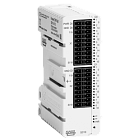 DIN Rail S010-X10 Digital add-on
Optional digital add-on module to the Kvaser DIN Rail SE400S-X10
Kvaser DIN Rail S010-X10 Digital is an optional add-on module to the Kvaser DIN Rail SE400S-X10 base module* with 16 digital inputs and 16 digital outputs. This IP20-rated module is thermal, reverse-polarity protected and surge power supply protected. A power LED displays the state of the module, whilst there are separate LEDs for each of the inputs and outputs.
*Please note: Add-on modules require a Kvaser DIN Rail SE400S-X10 to be able to work.
DIN Rail S010-X10 Digital add-on
Optional digital add-on module to the Kvaser DIN Rail SE400S-X10
Kvaser DIN Rail S010-X10 Digital is an optional add-on module to the Kvaser DIN Rail SE400S-X10 base module* with 16 digital inputs and 16 digital outputs. This IP20-rated module is thermal, reverse-polarity protected and surge power supply protected. A power LED displays the state of the module, whilst there are separate LEDs for each of the inputs and outputs.
*Please note: Add-on modules require a Kvaser DIN Rail SE400S-X10 to be able to work.
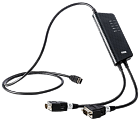 Hybrid 2xCAN/LIN
USB-2xCAN/LIN interface
Kvaser Hybrid 2xCAN/LIN is a flexible, dual channel interface that allows each channel to be assigned independently as CAN or LIN. This makes the Kvaser Hybrid 2xCAN/LIN a must-have ’universal interface’ for every engineer involved in automotive communications!
With a standard USB connector and two CAN/LIN channels in two separate 9-pin D-SUB connectors, this interface can connect a PC to two CAN buses, two LIN buses, or one CAN and one LIN bus.
Feature List:
Supports High Speed CAN (ISO 11898-2) up to 1Mbit/s and LIN 2.2A (ISO 17987 Part 1-7) up to 20 kbit/s
Capable of sending up to 20000 messages per second, per CAN channel
Supports CAN FD up to 5Mbit/s (with proper physical layer implementation)
Quick and easy plug-and-play installation
Supports CAN 2.0 A and CAN 2.0 B active
USB powered (bus V+ reference required for LIN)
LEDs indicate device status and bus activity
Galvanically isolated CAN buses
Fully compatible with J1939, CANopen, NMEA 2000 and DeviceNet
Supplied with Kvaser CANlib and Kvaser LINlib, free software APIs that are common to all Kvaser hardware and enable the channels to be configured intuitively and fast
Extended operating temperature range from -40 to 85 °C
Support for SocketCAN, see elinux.org for details
Software
Documentation, software and drivers can be downloaded for free at www.kvaser.com/downloads
Kvaser CANLIB SDK is a free resource that includes everything you need to develop software for the Kvaser CAN interfaces. Includes full documentation and many program samples, written in C, C++, C#, Delphi, Java, Python and Visual Basic
All Kvaser CAN interface boards share a common software API. Programs written for one interface type will run without modifications on the other interface types!
J2534 Application Programming Interface available
RP1210A Application Programming Interface available
Hybrid 2xCAN/LIN
USB-2xCAN/LIN interface
Kvaser Hybrid 2xCAN/LIN is a flexible, dual channel interface that allows each channel to be assigned independently as CAN or LIN. This makes the Kvaser Hybrid 2xCAN/LIN a must-have ’universal interface’ for every engineer involved in automotive communications!
With a standard USB connector and two CAN/LIN channels in two separate 9-pin D-SUB connectors, this interface can connect a PC to two CAN buses, two LIN buses, or one CAN and one LIN bus.
Feature List:
Supports High Speed CAN (ISO 11898-2) up to 1Mbit/s and LIN 2.2A (ISO 17987 Part 1-7) up to 20 kbit/s
Capable of sending up to 20000 messages per second, per CAN channel
Supports CAN FD up to 5Mbit/s (with proper physical layer implementation)
Quick and easy plug-and-play installation
Supports CAN 2.0 A and CAN 2.0 B active
USB powered (bus V+ reference required for LIN)
LEDs indicate device status and bus activity
Galvanically isolated CAN buses
Fully compatible with J1939, CANopen, NMEA 2000 and DeviceNet
Supplied with Kvaser CANlib and Kvaser LINlib, free software APIs that are common to all Kvaser hardware and enable the channels to be configured intuitively and fast
Extended operating temperature range from -40 to 85 °C
Support for SocketCAN, see elinux.org for details
Software
Documentation, software and drivers can be downloaded for free at www.kvaser.com/downloads
Kvaser CANLIB SDK is a free resource that includes everything you need to develop software for the Kvaser CAN interfaces. Includes full documentation and many program samples, written in C, C++, C#, Delphi, Java, Python and Visual Basic
All Kvaser CAN interface boards share a common software API. Programs written for one interface type will run without modifications on the other interface types!
J2534 Application Programming Interface available
RP1210A Application Programming Interface available
 USBcan R v2
2-channel CAN bus interface
Kvaser USBcan R v2 is a lightweight, yet highly durable, two channel CAN bus interface. The IP65-rated housing is made of aluminum alloy, sealed with a heavy-duty polyurethane coating that assures reliable protection against water and dust ingress, and is vibration, shock and drop proof.
With a standard USB2.0 connection and two high-speed CAN channels in two separate 9-pin D-SUB CAN connectors, the Kvaser USBcan R v2 handles transmission and reception of standard and extended CAN messages, with a time stamp precision of 100 microseconds. Features include error frame detection and LED indicators showing power and CAN channel status.
Major Features:
Connect to two CAN channels simultaneously using just one device.
IP65 rated lightweight aluminum housing, sealed with polyurethane coating.
Capable of sending up to 15000 messages per second, per channel, each time-stamped with 100 microsecond accuracies.
Quick and easy plug-and-play installation.
Supports High Speed CAN (ISO 11898-2) up to 1Mbit/s.
Supports both 11-bit (CAN 2.0A) and 29-bit (CAN 2.0B active) identifiers.
Power is taken from the USB bus.
Detection of error frames.
LED lights alert user to device status.
100% compatible with applications written for other Kvaser CAN hardware with Kvaser CANlib.
Fully compatible with J1939, CANopen, NMEA 2000 and DeviceNet.
Operating temperature range from −40 to 70°C.
Software
Documentation, software and drivers can be downloaded for free at www.kvaser.com/downloads.
Kvaser CANLIB SDK is a free resource that includes everything you need to develop software for the Kvaser CAN interfaces. Includes full documentation and many program samples, written in C, C++, C#, Delphi, Java, Python and Visual Basic.
All Kvaser CAN interface boards share a common software API. Programs written for one interface type will run without modifications on the other interface types!
J2534 Application Programming Interface available.
RP1210A Application Programming Interface available.
On-line documentation in Windows HTML-Help and Adobe Acrobat format.
USBcan R v2
2-channel CAN bus interface
Kvaser USBcan R v2 is a lightweight, yet highly durable, two channel CAN bus interface. The IP65-rated housing is made of aluminum alloy, sealed with a heavy-duty polyurethane coating that assures reliable protection against water and dust ingress, and is vibration, shock and drop proof.
With a standard USB2.0 connection and two high-speed CAN channels in two separate 9-pin D-SUB CAN connectors, the Kvaser USBcan R v2 handles transmission and reception of standard and extended CAN messages, with a time stamp precision of 100 microseconds. Features include error frame detection and LED indicators showing power and CAN channel status.
Major Features:
Connect to two CAN channels simultaneously using just one device.
IP65 rated lightweight aluminum housing, sealed with polyurethane coating.
Capable of sending up to 15000 messages per second, per channel, each time-stamped with 100 microsecond accuracies.
Quick and easy plug-and-play installation.
Supports High Speed CAN (ISO 11898-2) up to 1Mbit/s.
Supports both 11-bit (CAN 2.0A) and 29-bit (CAN 2.0B active) identifiers.
Power is taken from the USB bus.
Detection of error frames.
LED lights alert user to device status.
100% compatible with applications written for other Kvaser CAN hardware with Kvaser CANlib.
Fully compatible with J1939, CANopen, NMEA 2000 and DeviceNet.
Operating temperature range from −40 to 70°C.
Software
Documentation, software and drivers can be downloaded for free at www.kvaser.com/downloads.
Kvaser CANLIB SDK is a free resource that includes everything you need to develop software for the Kvaser CAN interfaces. Includes full documentation and many program samples, written in C, C++, C#, Delphi, Java, Python and Visual Basic.
All Kvaser CAN interface boards share a common software API. Programs written for one interface type will run without modifications on the other interface types!
J2534 Application Programming Interface available.
RP1210A Application Programming Interface available.
On-line documentation in Windows HTML-Help and Adobe Acrobat format.
 Memorator Pro 2xHS v2
CAN bus interface
Kvaser Memorator Pro 2xHS v2 is a professional-level, dual channel CAN bus interface and standalone data logger offering advanced features such as message filtering, triggers, error detection and generation, silent mode, an expandable SD card slot up to 64G, and galvanic isolation.
Connected to a PC with USB2.0, the Kvaser Memorator Pro 2xHS v2 operates as a powerful real time CAN to USB interface, whilst in data logger mode, the compact design of this device makes for the perfect flight recorder.
Configurable using Kvaser's Memorator Config Tool, this device is capable of running user-developed scripts, written in the Kvaser t programming language. Guidance in creating t programs is provided. The Kvaser Memorator Pro 2xHS v2 is CAN FD compliant.
Major Features:
Monitor two CAN channels simultaneously using just one device.
Log data to an expandable SD card slot.
Supports CAN FD up to 8Mbit/s (with proper physical layer implementation).
Script functionality allows users to develop customised t-script applications written in the Kvaser t programming language.
Power derived from the USB connection, CAN or an in-built power supply.
Supports silent mode for analysis tools – listens to the bus without interfering.
Detection and generation of error frames and remote frames.
LED lights alert user to device status, including signalling a full SD card or card error.
Galvanically isolated CAN bus drivers.
Automatically time synchronises the data transmitted and received across both buses.
Built-in Kvaser MagiSync technology time synchronises with other Kvaser interfaces connected to the same PC, resulting in simpler and more accurate multichannel data capture.
Extended operating temperature range from -40 to 85 °C.
NOTE: Product ships with Commercial Grade SD card (-25 to +85°C). Industrial Grade SD cards (-40 to +85°C) are available for additional purchase. Contact us for details.
Compatible with J1939, CANopen, NMEA 2000® and DeviceNet.
Plug and play installation, and a comprehensive user guide to help make t script development quick and easy.
Software:
Documentation, software and drivers can be downloaded for free at www.kvaser.com/downloads.
Kvaser CANLIB SDK is a free resource that includes everything you need to develop software for the Kvaser CAN interfaces. Includes full documentation and many program samples, written in C, C++, C#, Delphi, Java, Python and Visual Basic.
All Kvaser CAN interface boards share a common software API. Programs written for one interface type will run without modifications on the other interface types!
J2534 Application Programming Interface available.
RP1210A Application Programming Interface available.
On-line documentation in Windows HTML-Help and Adobe Acrobat format.
Memorator Pro 2xHS v2
CAN bus interface
Kvaser Memorator Pro 2xHS v2 is a professional-level, dual channel CAN bus interface and standalone data logger offering advanced features such as message filtering, triggers, error detection and generation, silent mode, an expandable SD card slot up to 64G, and galvanic isolation.
Connected to a PC with USB2.0, the Kvaser Memorator Pro 2xHS v2 operates as a powerful real time CAN to USB interface, whilst in data logger mode, the compact design of this device makes for the perfect flight recorder.
Configurable using Kvaser's Memorator Config Tool, this device is capable of running user-developed scripts, written in the Kvaser t programming language. Guidance in creating t programs is provided. The Kvaser Memorator Pro 2xHS v2 is CAN FD compliant.
Major Features:
Monitor two CAN channels simultaneously using just one device.
Log data to an expandable SD card slot.
Supports CAN FD up to 8Mbit/s (with proper physical layer implementation).
Script functionality allows users to develop customised t-script applications written in the Kvaser t programming language.
Power derived from the USB connection, CAN or an in-built power supply.
Supports silent mode for analysis tools – listens to the bus without interfering.
Detection and generation of error frames and remote frames.
LED lights alert user to device status, including signalling a full SD card or card error.
Galvanically isolated CAN bus drivers.
Automatically time synchronises the data transmitted and received across both buses.
Built-in Kvaser MagiSync technology time synchronises with other Kvaser interfaces connected to the same PC, resulting in simpler and more accurate multichannel data capture.
Extended operating temperature range from -40 to 85 °C.
NOTE: Product ships with Commercial Grade SD card (-25 to +85°C). Industrial Grade SD cards (-40 to +85°C) are available for additional purchase. Contact us for details.
Compatible with J1939, CANopen, NMEA 2000® and DeviceNet.
Plug and play installation, and a comprehensive user guide to help make t script development quick and easy.
Software:
Documentation, software and drivers can be downloaded for free at www.kvaser.com/downloads.
Kvaser CANLIB SDK is a free resource that includes everything you need to develop software for the Kvaser CAN interfaces. Includes full documentation and many program samples, written in C, C++, C#, Delphi, Java, Python and Visual Basic.
All Kvaser CAN interface boards share a common software API. Programs written for one interface type will run without modifications on the other interface types!
J2534 Application Programming Interface available.
RP1210A Application Programming Interface available.
On-line documentation in Windows HTML-Help and Adobe Acrobat format.
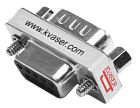 D-sub 9 pin 120 Ohm termination adapter
CAN adaptor
Kvaser D-sub 9 pin 120 Ohm termination adapter is a CAN adaptor with a 9-pin male D-Sub connector at one end and a 9-pin female D-Sub socket at the other. Between CAN High (pin 7) and CAN Low (pin 2) there is a built-in 120 Ohm CAN terminating resistor.
This adapter provides quick and easy termination to any Kvaser high-speed CAN product. The Kvaser CAN termination adapter is used when there is a need to terminate a CAN node without internal termination or when no CAN node is connected to the bus. The Kvaser D-sub 9 pin 120 Ohm termination adapter has a 9-pin male D-Sub plug connector and a 9-pin female D-Sub socket. A 120 ohm terminating resistor sits between pins 2 and 7.
D-sub 9 pin 120 Ohm termination adapter
CAN adaptor
Kvaser D-sub 9 pin 120 Ohm termination adapter is a CAN adaptor with a 9-pin male D-Sub connector at one end and a 9-pin female D-Sub socket at the other. Between CAN High (pin 7) and CAN Low (pin 2) there is a built-in 120 Ohm CAN terminating resistor.
This adapter provides quick and easy termination to any Kvaser high-speed CAN product. The Kvaser CAN termination adapter is used when there is a need to terminate a CAN node without internal termination or when no CAN node is connected to the bus. The Kvaser D-sub 9 pin 120 Ohm termination adapter has a 9-pin male D-Sub plug connector and a 9-pin female D-Sub socket. A 120 ohm terminating resistor sits between pins 2 and 7.
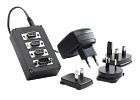 T-Cannector v2
CAN bus hub
Kvaser T-cannector v2 is a CAN bus hub with three female and one male D-SUB9 connectors. Used typically in application development scenarios, this offers an adjustable CAN termination resistor (120/60/0 Ohm) that provides an affordable and safe way of terminating the CAN circuit, as well as powering devices that take their power from the USB connection or the CAN network to which they are attached, such as Kvaser’s Blackbird and Memorator series. This device comes with a 12V power supply and EU, USA, UK and Chinese plugs.
Major Features of Kvaser T-cannector v2:
Acts as a CAN bus hub with 3 female and 1 male D-SUB9 connectors
Each DSUB9 has screws to secure the connection to the Kvaser CAN interface
Adjustable termination via easy-to-use switch
12V 1A power supply
LED to indicate power on
Voltage range of 12V-24V DC
This is a new version of an existing product that responds to user requests for more termination options. Notably our previous product came in two versions: with fixed termination of 120 Ohms and without. The Kvaser T-cannector v2 is extremely price-competitive, providing an external 12V 1A power source for Kvaser CAN interfaces and a safe, trustworthy means of circuit termination that protects customer’s interface investment and will prevent short circuits from damaging their development boards.
T-Cannector v2
CAN bus hub
Kvaser T-cannector v2 is a CAN bus hub with three female and one male D-SUB9 connectors. Used typically in application development scenarios, this offers an adjustable CAN termination resistor (120/60/0 Ohm) that provides an affordable and safe way of terminating the CAN circuit, as well as powering devices that take their power from the USB connection or the CAN network to which they are attached, such as Kvaser’s Blackbird and Memorator series. This device comes with a 12V power supply and EU, USA, UK and Chinese plugs.
Major Features of Kvaser T-cannector v2:
Acts as a CAN bus hub with 3 female and 1 male D-SUB9 connectors
Each DSUB9 has screws to secure the connection to the Kvaser CAN interface
Adjustable termination via easy-to-use switch
12V 1A power supply
LED to indicate power on
Voltage range of 12V-24V DC
This is a new version of an existing product that responds to user requests for more termination options. Notably our previous product came in two versions: with fixed termination of 120 Ohms and without. The Kvaser T-cannector v2 is extremely price-competitive, providing an external 12V 1A power source for Kvaser CAN interfaces and a safe, trustworthy means of circuit termination that protects customer’s interface investment and will prevent short circuits from damaging their development boards.
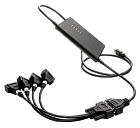 USBcan Light 4xHS
USB-CAN interface with 4 high speed CAN buses
The USBcan Light 4xHS is a compact, reliable and cost‑effective means of connecting four high speed CAN buses to a PC or mobile computer. With galvanic isolation as standard, this USB to quad channel CAN interface has a standard USB connector at one end and four high speed CAN channels in a single 26-pin HD D-SUB CAN connector at the other. The supplied HD26-4xDS9 splitter can be used to connect to four separate 9pin DSUB connectors.
USBcan Light 4xHS
USB-CAN interface with 4 high speed CAN buses
The USBcan Light 4xHS is a compact, reliable and cost‑effective means of connecting four high speed CAN buses to a PC or mobile computer. With galvanic isolation as standard, this USB to quad channel CAN interface has a standard USB connector at one end and four high speed CAN channels in a single 26-pin HD D-SUB CAN connector at the other. The supplied HD26-4xDS9 splitter can be used to connect to four separate 9pin DSUB connectors.
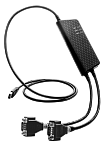 USBcan Pro 2xHS v2
USB-CAN interface with CAN FD support
The USBcan Pro 2xHS v2 is a USB to dual channel CAN or CAN FD interface with scripting capability. With a standard USB connector and two high-speed CAN channels with ISO 11898-2 compliant CAN transceivers in two separate 9-pin D-SUB CAN connectors, it is high-performance, yet compact, and can be used as a simple dual-channel interface to connect two high speed CAN buses to a PC or mobile computer, or can be programmed to do more. The Pro version is shipped with Kvaser TRX, a lightweight development environment that lowers the bar when starting out programming the device.
Feature List:
Supports CAN FD
Quick and easy plug-and-play installation
Supports both 11-bit (CAN 2.0A) and 29-bit (CAN 2.0B active) identifiers
Power is taken from the USB bus
Galvanic isolation
High-speed CAN connection (compliant with ISO 11898-2), up to 1 Mbit/s
Fully compatible with J1939, CANopen, NMEA 2000 and DeviceNet
Kvaser MagiSync provides automatic time synchronization between several PC-to-bus interfaces connected to the same PC
Programming functionality to support interface mode e.g. Optimize protocol handling, pre-filter CAN messages directly on the interface, or simulate missing hardware
Simultaneous operation of multiple devices
Software:
Documentation, software and drivers can be downloaded for free at www.kvaser.com/downloads
Units are shipped with Kvaser TRX, a lightweight development environment
Kvaser CANLIB SDK is a free resource that includes everything you need to develop software for the Kvaser CAN interfaces. Includes full documentation and many program samples, written in C, C++, C#, Delphi, and Visual Basic
All Kvaser CAN interface boards share a common software API. Programs written for one interface type will run without modifications on the other interface types!
J2534 Application Programming Interface available
RP1210A Application Programming Interface available
On-line documentation in Windows HTML-Help and Adobe Acrobat format
USBcan Pro 2xHS v2
USB-CAN interface with CAN FD support
The USBcan Pro 2xHS v2 is a USB to dual channel CAN or CAN FD interface with scripting capability. With a standard USB connector and two high-speed CAN channels with ISO 11898-2 compliant CAN transceivers in two separate 9-pin D-SUB CAN connectors, it is high-performance, yet compact, and can be used as a simple dual-channel interface to connect two high speed CAN buses to a PC or mobile computer, or can be programmed to do more. The Pro version is shipped with Kvaser TRX, a lightweight development environment that lowers the bar when starting out programming the device.
Feature List:
Supports CAN FD
Quick and easy plug-and-play installation
Supports both 11-bit (CAN 2.0A) and 29-bit (CAN 2.0B active) identifiers
Power is taken from the USB bus
Galvanic isolation
High-speed CAN connection (compliant with ISO 11898-2), up to 1 Mbit/s
Fully compatible with J1939, CANopen, NMEA 2000 and DeviceNet
Kvaser MagiSync provides automatic time synchronization between several PC-to-bus interfaces connected to the same PC
Programming functionality to support interface mode e.g. Optimize protocol handling, pre-filter CAN messages directly on the interface, or simulate missing hardware
Simultaneous operation of multiple devices
Software:
Documentation, software and drivers can be downloaded for free at www.kvaser.com/downloads
Units are shipped with Kvaser TRX, a lightweight development environment
Kvaser CANLIB SDK is a free resource that includes everything you need to develop software for the Kvaser CAN interfaces. Includes full documentation and many program samples, written in C, C++, C#, Delphi, and Visual Basic
All Kvaser CAN interface boards share a common software API. Programs written for one interface type will run without modifications on the other interface types!
J2534 Application Programming Interface available
RP1210A Application Programming Interface available
On-line documentation in Windows HTML-Help and Adobe Acrobat format
 Leaf Light HS v2 OBDII
USB-CAN interface
The Leaf Light v2 OBDII provides a simple way of connecting a PC with a vehicle’s on-board computer by means of USB 2.0 connector and a 16-pin OBDII-compliant CAN connector. Having made its name as the work-horse of USB to CAN interfaces, Kvaser’s Leaf Light product series provides reliable, low cost tools for connecting any CAN network to a PC or mobile computer in vehicle diagnostic applications and beyond.
Leaf Light HS v2 OBDII
USB-CAN interface
The Leaf Light v2 OBDII provides a simple way of connecting a PC with a vehicle’s on-board computer by means of USB 2.0 connector and a 16-pin OBDII-compliant CAN connector. Having made its name as the work-horse of USB to CAN interfaces, Kvaser’s Leaf Light product series provides reliable, low cost tools for connecting any CAN network to a PC or mobile computer in vehicle diagnostic applications and beyond.
 BlackBird v2
Wireless USB/CAN PC interface
Yet more powerful and versatile a WLAN solution than Kvaser’s original BlackBird, Kvaser BlackBird v2 incorporates a new radio chip that gives it up to 75% better range. In addition, more onboard memory overcomes potential interruptions to the wireless connection due to the protocol itself or disturbance.
The BlackBird v2’s ability to leverage existing wireless infrastructure makes it ideal for replacing cumbersome cable, accessing hard-to-reach CAN networks, or for monitoring a CANbus while in motion. Based on radio chip that is Wi-Fi certified and meets CE and FCC standards, it works in both Ad Hoc and Infrastructure mode. The Blackbird v2’s API is device independent and so can be used on a tablet or smartphone, as well as PC.
Major features:
- WLAN version 802.11b/g/n
- Responds to increased market demand for iOS and Android API with a device independent http based REST API
- 100% software compatible with applications written for all Kvaser hardware with free Kvaser CANlib SDK
- Up to 75% better range
- Works in AdHoc and Infrastructure mode
- Lightweight but highly rugged aluminum housing
- Polyurethane cabling suitable for extreme environments
- Galvanic isolation of the CAN bus driver stage to protect the hardware
- Interfaces the CAN bus with a standard D-SUB connector
- Configured by USB connection
- Can be used as a wired interface
- Operating voltage CAN bus (7 — 40 V DC)
- Messages are time-stamped and synchronized with a precision of 25 microsecond
- Supports 11-bit and 29-bit identifiers
- Comes with free, first class technical support
BlackBird v2
Wireless USB/CAN PC interface
Yet more powerful and versatile a WLAN solution than Kvaser’s original BlackBird, Kvaser BlackBird v2 incorporates a new radio chip that gives it up to 75% better range. In addition, more onboard memory overcomes potential interruptions to the wireless connection due to the protocol itself or disturbance.
The BlackBird v2’s ability to leverage existing wireless infrastructure makes it ideal for replacing cumbersome cable, accessing hard-to-reach CAN networks, or for monitoring a CANbus while in motion. Based on radio chip that is Wi-Fi certified and meets CE and FCC standards, it works in both Ad Hoc and Infrastructure mode. The Blackbird v2’s API is device independent and so can be used on a tablet or smartphone, as well as PC.
Major features:
- WLAN version 802.11b/g/n
- Responds to increased market demand for iOS and Android API with a device independent http based REST API
- 100% software compatible with applications written for all Kvaser hardware with free Kvaser CANlib SDK
- Up to 75% better range
- Works in AdHoc and Infrastructure mode
- Lightweight but highly rugged aluminum housing
- Polyurethane cabling suitable for extreme environments
- Galvanic isolation of the CAN bus driver stage to protect the hardware
- Interfaces the CAN bus with a standard D-SUB connector
- Configured by USB connection
- Can be used as a wired interface
- Operating voltage CAN bus (7 — 40 V DC)
- Messages are time-stamped and synchronized with a precision of 25 microsecond
- Supports 11-bit and 29-bit identifiers
- Comes with free, first class technical support
